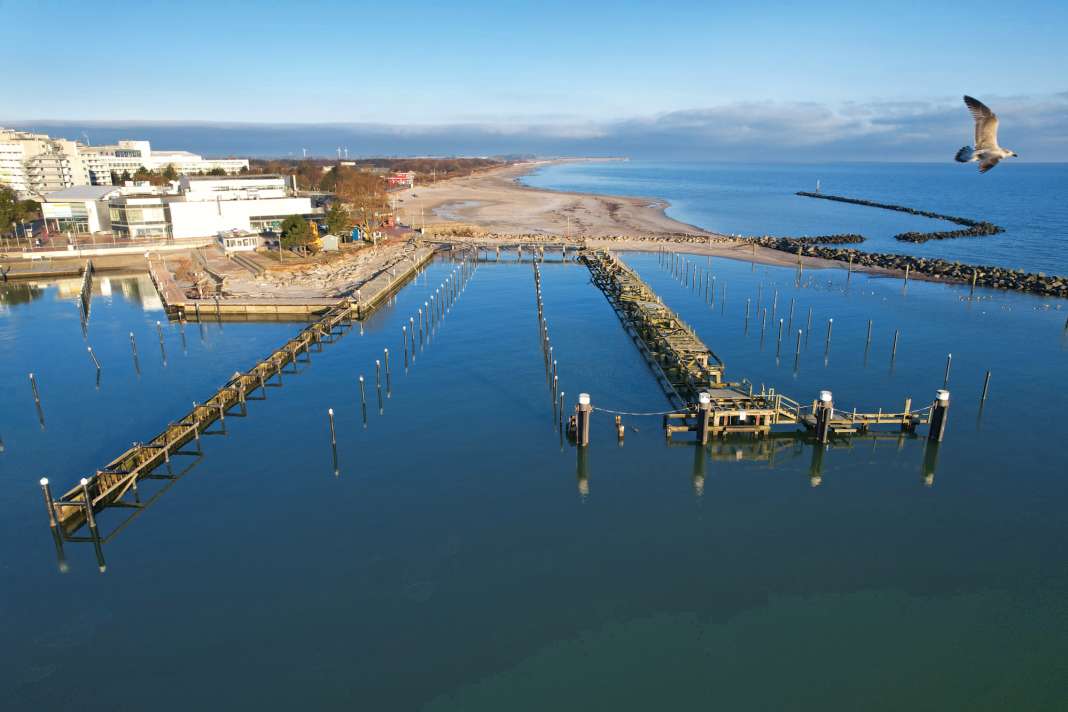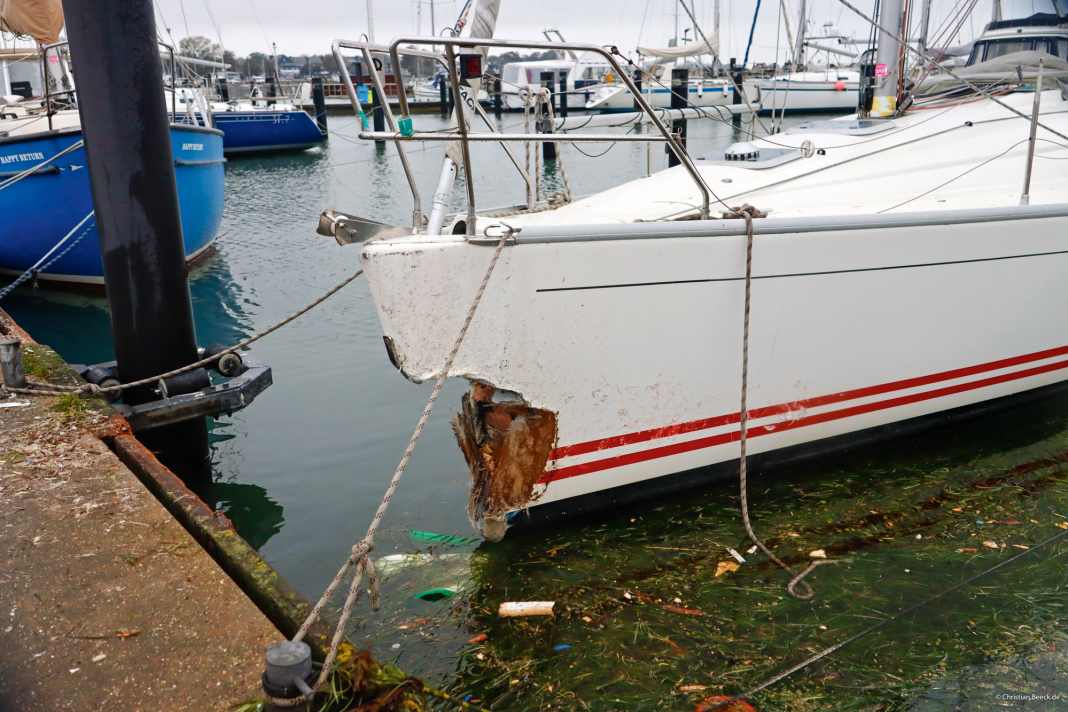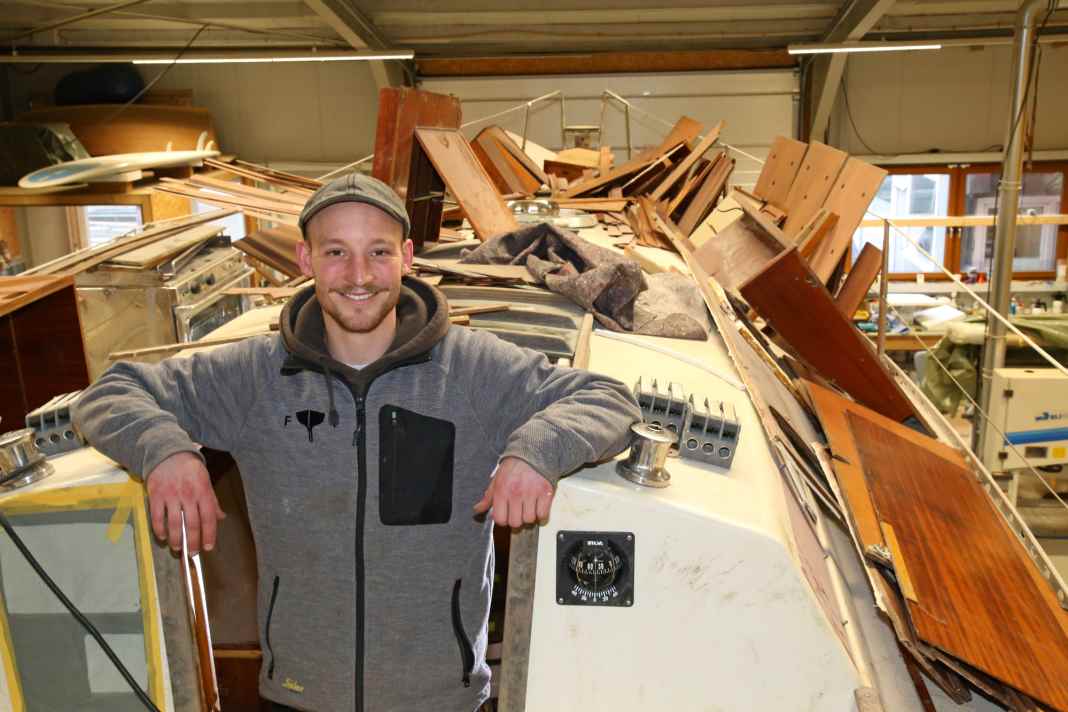Baltic Sea storm surge: Current status of the damage - ready for the comeback?
Andreas Fritsch
· 05.02.2024






Once the initial shock of devastated harbours and sunken or badly damaged yachts had been overcome, a race against time began almost immediately: hundreds of owners had to secure their boats and have them inspected, as well as find a shipyard in the already busy facilities on the coast. Those who had been badly hit by the storm surge even had to start looking for a new ship. Harbour operators, on the other hand, were confronted with jetties smashed by the storm and waves. They had to drive new piles, replace entire jetties, mend or raise piers, repair electricity and water pipes and the associated columns. And all this until the season starts again.
But five months is not long. Anyone who knows about the capacity utilisation of the few hydraulic engineering companies, material bottlenecks and the shortage of skilled workers already suspected in November that things could get tight. Reason enough to go on a flying visit along the coast: What has happened in the harbours since the disaster? And how are boat repairs progressing in the shipyards, where damaged motorboats and sailing boats are lined up in a queue?
The Schilksee marina, operated by Sporthafen Kiel GmbH, was one of the hardest hit. Shortly after the disaster, the question arose as to whether Kiel Week was in jeopardy. At the same time, hundreds of permanent berth holders trembled for their places; alternative options are rare in the harbours that are fully booked almost everywhere along the coast. In Kiel alone, around 400 owners and their ships were on the waiting list for 2023.
The situation in Kiel three months after the Baltic Sea storm surge
A site visit in mid-January with the Managing Director of Sporthafen Kiel GmbH, Philipp Mühlenhardt, provides a surprisingly good first impression of the current situation in Schilksee: the chaos has been cleared up. There are still around a dozen damaged boats on the site. Some are adorned with stickers, mostly from Polish boat builders: "I will buy your boat!" But Mühlenhardt waves them away: "Of course, the bargain hunters were all there long ago. But most of the boats have already been distributed to shipyards and service companies - or scrapped."
The man from Kiel knows what he's talking about, he was hit himself. His Sweden Yacht 340 had huge holes and cracks in the hull after the storm. He arrived frantically from his holiday shortly before the storm, secured everything that could be secured and deployed countless lines. To no avail. The ship is now at the Knierim shipyard. The assessed damage is a hair's breadth below the insurance value. "We didn't want to part with it, as there are many memories attached to the boat. Ultimately, it was a gut decision," says Mühlenhardt. The worst of the damage to his boat has now been repaired and he can look forward to next summer. Other owners feel the same way.
Meanwhile, in Schilksee, workmen are rebuilding the main jetties in the freezing east wind and sub-zero temperatures. Some are still stripped down to the substructure, only new T-beams have already been installed. "We bought urgently needed material in stock immediately after the storm. We suspected that supply bottlenecks were imminent," says the harbour manager. GRP substructure beams, timber, lattice panels - a lot is ready or has already been installed. Even the harbour basin has been resurveyed, the debris removed by divers and the entrance checked for silting. "We were lucky, the survey boat of a nautical chart publisher was available."
Breakwater was affected by storm surge
Mühlenhardt is optimistic. "We will manage Kiel Week, and the berths should also be clear. However, the repair of electricity columns and water connections may take longer here and there." The breakwater made of natural stone has also visibly suffered. It will be raised to its old height of 2.5 metres by the end of the season. But the question is: doesn't it need to be significantly raised for the future? As it turns out later, other harbours such as Damp and Maasholm are also facing the same problem.
"Of course, an increase would make sense for the future. But unfortunately that would be very costly," explains Mühlenhardt. You can't simply raise the existing breakwater by one metre. The existing stones would not hold up. They are not suitable as a foundation for a further structure. Meaning: new construction. "This is a multi-million euro project. The question of how to manage it will keep us busy for a while longer."
We are optimistic that all pitches in Schilksee will be ready for use again at the start of the season - electricity and water perhaps a little later"
The state of Schleswig-Holstein had promised rapid assistance after the storm surge. An initial paper from Kiel stated that a reconstruction fund from the state and local authorities would support 75 per cent of the costs for infrastructure facilities. However, the necessary funding guidelines have still not been published and time is running out before the start of the season.
Unresolved funding issues are also slowing down work in Damp and Maasholm, as confirmed by the mayor of Damp and the management of the municipality of Maasholm. In Damp, a huge construction fence blocks off the harbour area, which still shows clear signs of devastation. Mayor Barbara Feyock reports: "We are waiting for the funding guidelines and we have to discuss with the harbour tenant how to proceed. The stone pier has sunk by a metre in places, so there is a need for action."
Progress is being made elsewhere
It is currently not possible to predict when the harbour will be fully operational again. Smaller municipalities are not in a position to raise the necessary funds on their own. In Eckernförde, for example, the damage caused by the storm surge to beaches and facilities close to the shore is estimated at over three million euros. The town councillors have therefore now decided to levy a storm surge tax of 50 cents on the visitor's tax for a limited period. The aim is to raise 500,000 euros in this way. Necessity is the mother of invention.
Elsewhere, however, things are progressing quickly: the owners of Lindaunis harbour on the Schlei surprised everyone before Christmas with the good news that the damage to the jetties caused by the storm surge had been repaired and that they were now getting to work on restoring the supply connections. This is an advantage for the private sector, although it does not receive any funding.
The Im-Jaich Group, which operates seven marinas in northern Germany, also reports that damage is already being diligently repaired. "We have to replace the supply pillars in Eckernförde and Flensburg. Repairing the damage in Langballigau is more complex, as the service buildings were flooded," says Hans Jaich. In Lauterbach on the island of Rügen, the stone jetty will probably also have to be raised in order to be prepared for the future.
Funding is required
It is not possible to say exactly how much damage has been caused to the harbours along the German coast due to the lack of a large, cohesive interest group. The situation is different in Denmark, where Flid, the association of marina operators, puts the costs at around twelve million euros. 59 ports are affected in the neighbouring country, in four of which the damage exceeds 1.5 million euros. A funding pot has been promised to support the local authorities with 25 per cent of the costs.
Carsten Kock is one man for whom this is of little help. He runs the private marina in Mommark, which is also popular with many German crews. The storm surge practically destroyed the harbour completely. "I estimate the damage at around 1.5 million euros," says Kock. "All the jetties are broken, but above all the wall of the concrete jetty has been demolished. Without its protection to the east, it makes no sense to start repairing the jetties," says the Dane.
He is hoping for funding, but also has an ace up his sleeve in case of an emergency: He has had plans in the drawer for two years to expand Mommark by 160 berths. A new, stronger stone pier would then protect the harbour and a concrete wall on the pier just as high as before would probably suffice on the inside. "If that is approved, the harbour would have a chance," believes Kock. So for the time being, only the restaurant and campsite will probably reopen, the harbour only for the fishermen.
High-tech repair with 3D laser scanner
Huge holes in the hulls, ugly scratches deep into the laminate, burst hull-deck connections: Many owners are also facing major challenges. Quite a few were deeply shocked, some were in tears when they found their ships destroyed, sunk or badly damaged. Fortunately, two months later, there are some initial examples that offer hope. At the Knierim shipyard, for example, even extremely difficult cases are being repaired. Whether it's broken bow sections, gaping holes in the sides of the hull or dented transoms, there is hardly any damage that they can't repair here thanks to a lot of high-tech.




Boat builder Jens Langwasser explains how the shipyard solves the more complicated cases: "We capture the existing hull shape with 3D scanners, convert the data into corresponding construction drawings on the computer and then digitally replace the missing piece. This is even easier with corner pieces, where we scan the other side, which is often intact, and mirror it on the computer." The required component is then calculated. "We then mill it out of polystyrene as a negative mould," says Langwasser. The part is then laminated with millimetre precision and finally laminated to the fuselage by means of a stock.
As you walk through the halls, you can see this impressively on a large motor yacht. A sailing yacht with a broken bow will follow shortly. And ingenuity is also required for other types of damage. For example, because previously used one-piece aluminium foot railings are no longer available. Boat builders are replacing them with new ones, which are now usually assembled in several pieces. Spare parts are difficult to find, especially for older boats, resulting in long delivery times. So it's no wonder that we're often hearing these days that the boat builders on the coast will easily have until the end of 2024 to repair the storm-damaged yachts.
Numerous repairs after the Baltic Sea storm surge
The story of a kind of boat resurrection is almost touching: the Bothmer family's Hanseat 68 sank in Schilksee. The grandparents bought the boat in the 1960s and four generations have learnt to sail on it since then. "As a child, I spent my summer holidays on our 'Persante' with my parents. Later, we sailed on it with our children. Now they take their children with them," says Brita Bothmer.
And then came the storm surge, and the Hanseat sank at the berth. Only the wooden mast was still sticking out of the water. She lay there for seven days. The insurance company didn't hesitate for long: in view of the sum insured of 30,000 euros, it certified a total economic loss. In desperation, the family looked at second-hand Hanseats on the Internet. "But I was unfamiliar with the other boats. Hanseats are very individually equipped, many things were constantly changed during the construction phase. The other boats were simply not like ours," says Brita Bothmer.
So the decision is made: "Persante" will be saved, whether the insurance sum is enough or not. As soon as the boat floats out of the water onto land, it becomes clear that the decision was the right one: as soon as it is on the trestle and the water has been drained and the coarsest dirt removed, the grandchildren climb into the cockpit and make imaginary turns.
The Bothmers rinse the boat, empty it and give the sails to be cleaned. Then the Hanseat is taken to the nearby Förde shipyard. They dry the boat and get started a little later. By the end of the year, the hole in the hull is closed and new paint is applied. "We want to get going at the start of the season," says Brita Bothmer. You don't give up on family members.
Rescue of a Luffe 37
Bastian Kemper also shows what is possible in such a rescue. The boat builder is working at the Förde shipyard when the storm breaks out. Together with his boss Paul Kröber, he is still on site that night, securing boats with additional lines and trying to save what can be saved. In the days that followed, they were in constant action, helping to salvage the wrecks, carrying out removals and helping to assess what could be repaired.
At some point during these days, "Elida" hangs on the crane hook. The Luffe 37 has been under water for four days, has square metre-sized damage and holes in the hull, and the rudder is splintered. And yet, the yacht is a beauty. "When we got her out of the crane, the insurance company said it was a total loss and we should take the boat for scrapping," says 30-year-old Kemper. Master and journeyman look at each other and both think: "What a shame, something should be done!"



They buy the wreck for a symbolic euro. After work, Kemper devotes himself to the Luffe, rinsing it with fresh water for days, removing mud and dirt from the interior and dismantling the machine. Water is extracted using a vacuum pump via holes drilled in the bulkheads and other wooden parts. Construction dryers drive out the moisture. Basti, as everyone here calls him, dismantles the interior fittings, meticulously labelling every single piece of wood, which now lie on deck like pieces of a gigantic jigsaw puzzle. "The boatbuilding quality is super solid. We were amazed at how good the wooden parts still look, for example. Nothing is swollen or warped, no detached veneers, very little discolouration."
The boat builders are astonished when, after draining and cleaning, even the navigation electronics are up and running without complaint. When we visit the shipyard, we are surprised to find that it doesn't smell damp or musty below deck. It looks like a lot of work, but after all, the man is a professional. The two square metres of damage to the hull is already being repaired: first the inner laminate layer has to be repaired from the inside, then the defective core material removed from the outside and new material glued in. The outer laminate is then rebuilt.
The only limiting factor is the budget: Kemper had already saved up 15,000 euros to buy a smaller boat, which he now has to make do with. "My goal is to sail the boat for four weeks this summer. Not everything inside has to be finished yet." Anyone looking into his shining eyes as he says this will wish him success.
No matter which hall you look into, there are still victims of the storm surge almost everywhere. Like at the Damp Yacht Centre. Managing Director Martin Janssen shows how employees are working on three yachts at the same time. None of them have seen damage on this scale before. But the team is tackling it.
We can only hope that many more affected owners will be able to make a comeback with their boats. And that the damage in the harbours is repaired as soon as possible. At the moment, there are some indications that this could work out in many places.
Balance of the Baltic Sea storm surge in figures
430 Damage
have been registered by Pantaenius alone. The insurance experts estimate the total number of yachts affected at between 1,300 and 1,700
73 Ships
has classified Pantaenius as a total loss. There could be up to 300 yachts in total
9.2 million euros
the loss amount at Pantaenius has so far been
28 days
salvage team members were out and about in the harbours, with only one night at home
200 million euros
a reconstruction fund is to be provided by the state and municipalities
90 per cent
Funding to be provided for coastal protection projects

